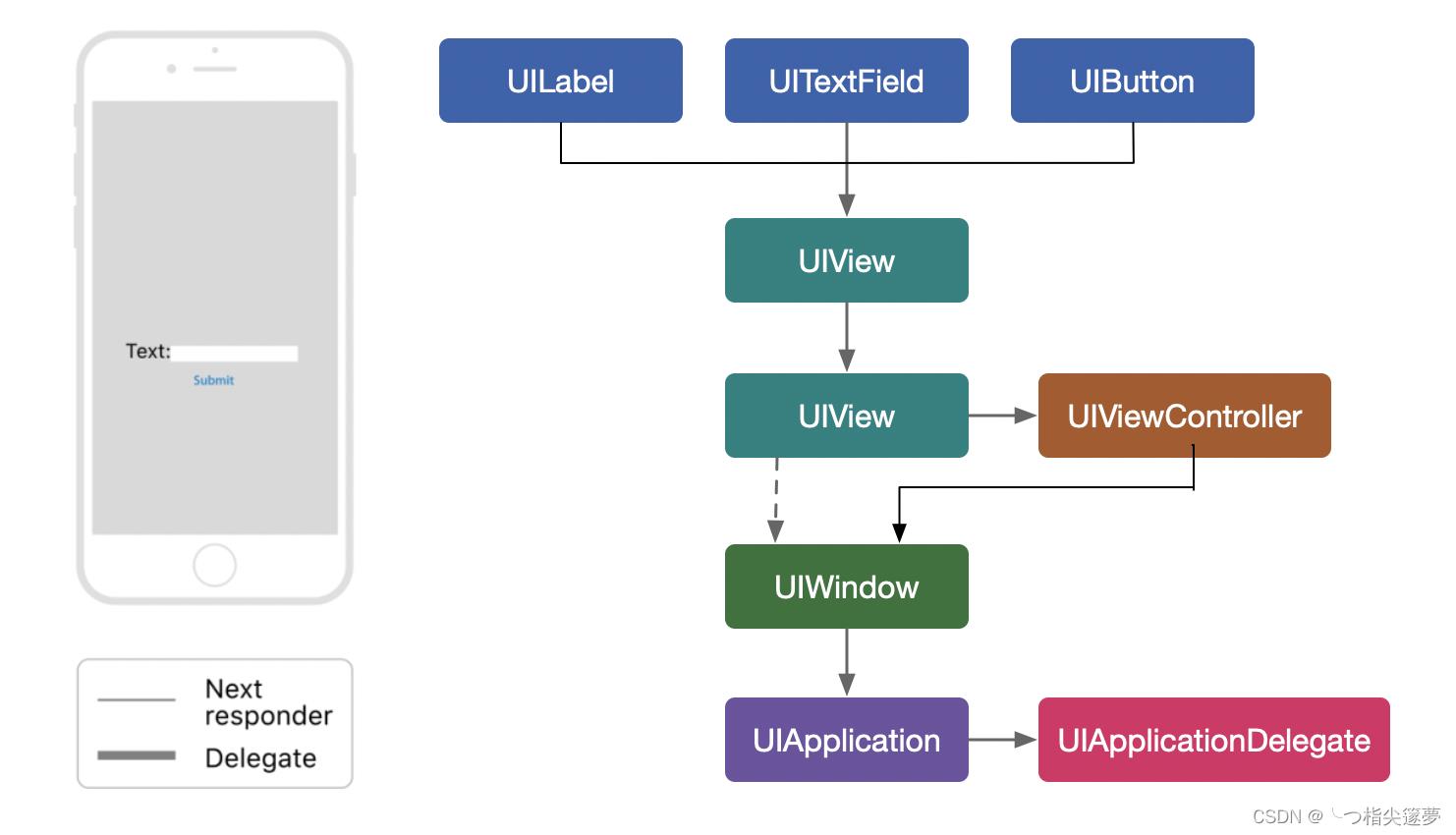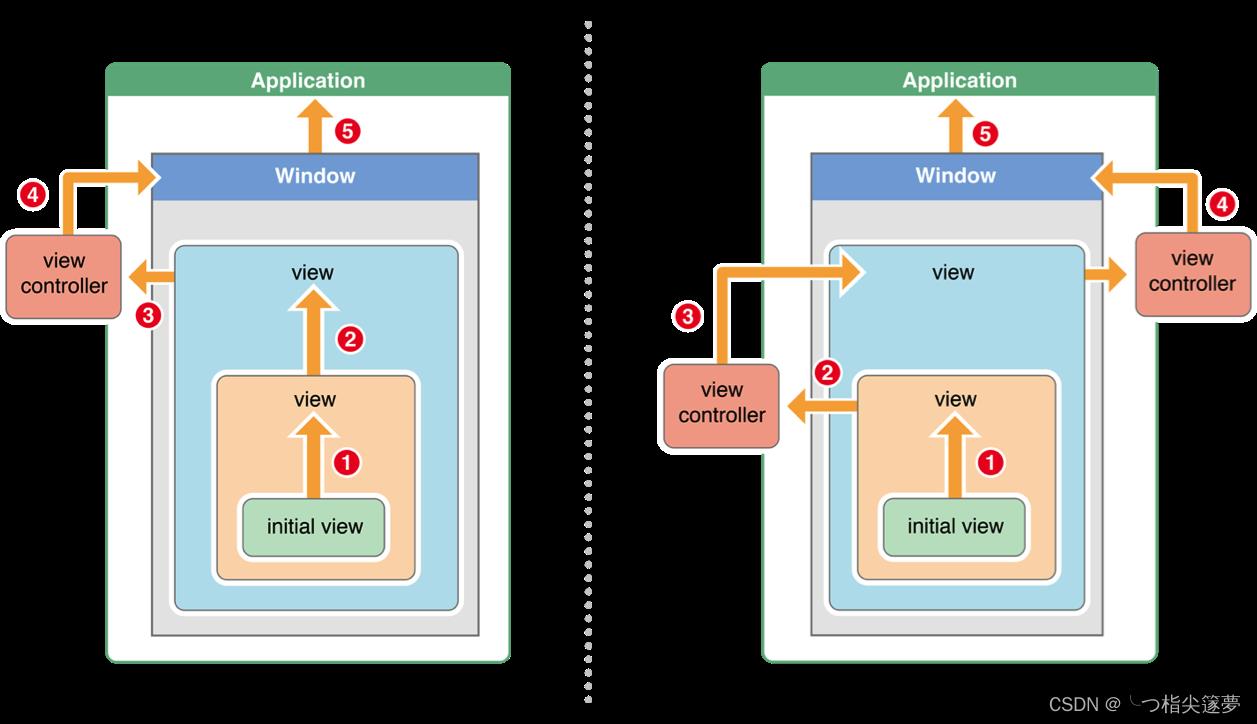iOS之深入解析响应者链Responder Chain
Posted ╰つ栺尖篴夢ゞ
tags:
篇首语:本文由小常识网(cha138.com)小编为大家整理,主要介绍了iOS之深入解析响应者链Responder Chain相关的知识,希望对你有一定的参考价值。
一、响应链事件
- ios 中的事件可分为:触摸事件(multitouch events)、加速计事件(accelerometer events)、远程控制事件(remote control events)。
| Event type | First responder |
|---|---|
| Touch events | The view in which the touch occurred |
| Press events | The object that has focus |
| Shake-motion events | The object that you (or UIKit) designate |
| Remote-control events | The object that you (or UIKit) designate |
| Editing menu messages | The object that you (or UIKit) designate |
- 响应者链 Responder Chain:

二、响应者对象
- 在 iOS 中不是任何对象都能处理事件,只有继承 UIResponder 的对象才能接收并处理事件,称之为“响应者对象”。
- UIApplication、UIViewController、UIView 都继承于 UIResponder。UIResponder 内部提供了以下方法来处理触摸事件:
// 一根或者多根手指开始触摸view,系统会自动调用view的下面方法
- (void)touchesBegan:(NSSet<UITouch *> *)touches withEvent:(nullable UIEvent *)event;
// 一根或者多根手指在view上移动,系统会自动调用view的下面方法(随着手指的移动,会持续调用该方法)
- (void)touchesMoved:(NSSet<UITouch *> *)touches withEvent:(nullable UIEvent *)event;
// 一根或者多根手指离开view,系统会自动调用view的下面方法
- (void)touchesEnded:(NSSet<UITouch *> *)touches withEvent:(nullable UIEvent *)event;
// 触摸结束前,某个系统事件(例如电话呼入)会打断触摸过程,系统会自动调用view的下面方法[可选]
- (void)touchesCancelled:(nullable NSSet<UITouch *> *)touches withEvent:(nullable UIEvent *)event;
- 加速计事件:
- (void)motionBegan:(UIEventSubtype)motion withEvent:(nullable UIEvent *)event NS_AVAILABLE_IOS(3_0);
- (void)motionEnded:(UIEventSubtype)motion withEvent:(nullable UIEvent *)event NS_AVAILABLE_IOS(3_0);
- (void)motionCancelled:(UIEventSubtype)motion withEvent:(nullable UIEvent *)event NS_AVAILABLE_IOS(3_0);
- 远程控制事件:
- (void)remoteControlReceivedWithEvent:(nullable UIEvent *)event NS_AVAILABLE_IOS(4_0);
- 当用户用一根手指触摸屏幕时,会创建一个与手指相关联的 UITouch 对象;一根手指对应一个 UItouch 对象。
三、UITouch
- 当用户用一根手指触摸屏幕时,会创建一个与手指相关联的 UITouch 对象,一根手指对应一个 UITouch 对象。
- UITouch 的作用:保存着跟手指相关的信息,比如触摸的位置、时间、阶段。当手指移动时,系统会更新同一个 UITouch 对象,使之能够一直保存该手指的触摸位置;当手指离开屏幕时,系统会销毁相应的 UITouch 对象。
- UITouch 的属性:
// 记录了触摸事件产生或变化时的时间,单位是秒 The relative time at which the acceleration event occurred(read-only)
@property(nonatomic,readonly) NSTimeInterval timestamp;
// 当前触摸事件所处的状态
@property(nonatomic,readonly) UITouchPhase phase;
// touch down within a certain point within a certain amount of timen 短时间内点按屏幕的次数,可以根据tapCount判断单击、双击或更多的点击
@property(nonatomic,readonly) NSUInteger tapCount;
@property(nonatomic,readonly) UITouchType type NS_AVAILABLE_IOS(9_0);
// 触摸产生时所处的窗口
@property(nullable,nonatomic,readonly, strong) UIWindow *window;
// 触摸产生时所处的视图
@property(nullable,nonatomic,readonly, strong) UIView *view;
// The gesture-recognizer objects currently attached to the view.
@property(nullable,nonatomic,readonly,copy) NSArray <UIGestureRecognizer *> *gestureRecognizers
- UITouch 的方法:
/*返回值表示触摸在view上的位置
这里返回的位置是针对view的坐标系的(以view的左上角为原点(0, 0))
调用时传入的view参数为nil的话,返回的是触摸点在UIWindow的位置*/
- (CGPoint)locationInView:(nullable UIView *)view;
// 该方法记录了前一个触摸点的位置
- (CGPoint)previousLocationInView:(nullable UIView *)view;
四、UIEvent
- 每产生一个事件,就会产生一个 UIEvent 对象,UIEvent 称为事件对象,记录事件产生的时刻和类型。
- 事件类型的常见属性:
@property(nonatomic,readonly) UIEventType type NS_AVAILABLE_IOS(3_0);
@property(nonatomic,readonly) UIEventSubtype subtype NS_AVAILABLE_IOS(3_0);
- 事件产生时间的常见属性:
@property(nonatomic,readonly) NSTimeInterval timestamp;
- 获取 touch 对象的方法:
- (nullable NSSet <UITouch *> *)allTouches;
- (nullable NSSet <UITouch *> *)touchesForWindow:(UIWindow *)window;
- (nullable NSSet <UITouch *> *)touchesForView:(UIView *)view;
- (nullable NSSet <UITouch *> *)touchesForGestureRecognizer:(UIGestureRecognizer *)gesture NS_AVAILABLE_IOS(3_2);
// An array of auxiliary UITouch’s for the touch events that did not get delivered for a given main touch. This also includes an auxiliary version of the main touch itself.
- (nullable NSArray <UITouch *> *)coalescedTouchesForTouch:(UITouch *)touch NS_AVAILABLE_IOS(9_0);
// An array of auxiliary UITouch’s for touch events that are predicted to occur for a given main touch. These predictions may not exactly match the real behavior of the touch as it moves, so they should be interpreted as an estimate.
- (nullable NSArray <UITouch *> *)predictedTouchesForTouch:(UITouch *)touch NS_AVAILABLE_IOS(9_0);
五、什么是响应者链?
- iOS 中的响应者链(Responder Chain)是用于确定事件响应者的一种机制,其中的事件主要指触摸事件(Touch Event),该机制和 UIKit 中的 UIResponder 类紧密相关。响应触摸事件的都是屏幕上的界面元素,而且必须是继承自 UIResponder 类的界面类(包括各种常见的视图类及其视图控制器类,如 UIView 和 UIViewController)才可以响应触摸事件。
- 一个事件响应者的完成主要经过两个过程:hitTest 方法命中视图和响应者链确定响应者。hitTest 方法首先从顶部 UIApplication 往下调用(从父类到子类),直到找到命中者,然后从命中者视图沿着响应者链往上传递寻找真正的响应者。
- 命中测试(hitTest)主要会用到视图类的 hitTest 函数和 pointInside 函数。其中,前者用于递归寻找命中者,后者则是检测当前视图是否被命中,即触摸点坐标是否在视图内部。当触摸事件发生后,系统会将触摸事件以 UIEvent 的方式加入到 UIApplication 的事件队列中,UIApplication 将事件分发给根部的 UIWindow 去处理,UIWindow 则开始调用 hitTest 方法进行迭代命中检测。
- 命中检测具体迭代的过程为:如果触摸点在当前视图内,那么递归对当前视图内部所有的子视图进行命中检测;如果不在当前视图内,那么返回 NO 停止迭代。这样最终会确定屏幕上最顶部的命中的视图元素,即命中者。
- 通过命中测试找到命中者后,任务并没有完成,因为最终的命中者不一定是事件的响应者。所谓的响应就是开发中为事件绑定的一个触发函数,事件发生后执行响应函数里的代码,例如通过 addTarget 方法为按钮的单击事件绑定响应函数,在按钮被单击后能及时执行想要执行的任务。
六、完整的触摸过程
- 一次完整的触摸过程,会经历 3 个状态:
触摸开始:- (void)touchesBegan:(NSSet *)touches withEvent:(UIEvent *)event
触摸移动:- (void)touchesMoved:(NSSet *)touches withEvent:(UIEvent *)event
触摸结束:- (void)touchesEnded:(NSSet *)touches withEvent:(UIEvent *)event
触摸取消(可能会经历):- (void)touchesCancelled:(NSSet *)touches withEvent:(UIEvent *)event
- 4 个触摸事件处理方法中,都有 NSSet *touches 和 UIEvent *event 两个参数。
- 一次完整的触摸过程中,只会产生一个事件对象,4 个触摸方法都是同一个 event 参数。
- 如果两根手指同时触摸一个 view,那么 view 只会调用一次 touchesBegan:withEvent: 方法,touches 参数中装着 2 个 UITouch 对象。
- 如果这两根手指一前一后分开触摸同一个 view,那么 view 会分别调用 2 次 touchesBegan:withEvent: 方法,并且每次调用时的 touches 参数中只包含一个 UITouch 对象。
- 根据 touches 中 UITouch 的个数可以判断出是单点触摸还是多点触,判断多少次点击:UITouch 的属性 @property(nonatomic,readonly) NSUInteger tapCount;
- 事件的产生和传递:
-
- 发生触摸事件后,系统会将该事件加入到一个由 UIApplication 管理的事件队列中;
-
- UIApplication 会从事件队列中取出最前面的事件,并将事件分发下去以便处理,通常先发送事件给应用程序的主窗口(keyWindow);
-
- 主窗口会在视图层次结构中找到一个最合适的视图来处理触摸事件,但是这仅仅是整个事件处理过程的第一步;
-
- 找到合适的视图控件后,就会调用视图控件的 touches 方法来作具体的事件处理。
touchesBegan…
touchesMoved…
touchedEnded…

- UIView 不接收触摸事件的三种情况:
-
- 不接收用户交互userInteractionEnabled = NO;
-
- 隐藏 hidden = YES;
-
- 透明 alpha = 0.0 ~ 0.01。
- UIImageView 的 userInteractionEnabled 默认就是 NO,因此 UIImageView 以及它的子控件默认是不能接收触摸事件的。
七、响应者链的事件传递过程
- 响应者链的事件传递过程:
-
- 如果 view 的控制器存在,就传递给控制器;如果控制器不存在,则将其传递给它的父视图;
-
- 在视图层次结构的最顶级视图,如果也不能处理收到的事件或消息,则其将事件或消息传递给 window 对象进行处理;
-
- 如果 window 对象也不处理,则其将事件或消息传递给 UIApplication 对象;
-
- 如果 UIApplication 也不能处理该事件或消息,则将其丢弃。
- 触摸事件处理的详细过程:
-
- 用户点击屏幕后产生的一个触摸事件,经过一系列的传递过程后,会找到最合适的视图控件来处理这个事件;
-
- 找到最合适的视图控件后,就会调用控件的 touches 方法来作具体的事件处理;
-
- 这些 touches 方法的默认做法是将事件顺着响应者链条向上传递,将事件交给上一个响应者进行处理。响应者链条就是由多个响应者对象连接起来的链条,能很清楚地看见每个响应者之间的关系,并且可以让一个事件多个对象处理:

- 如何判断上一个响应者:
-
- 如果当前这个 view 是控制器的 view,那么控制器就是上一个响应者;
-
- 如果当前这个 view 不是控制器的 view,那么父控件就是上一个响应者。
- 事件传递的完整过程:
-
- 先将事件对象由上往下传递(由父控件传递给子控件),找到最合适的控件来处理这个事件;
-
- 调用最合适控件的 touches…. 方法;
-
- 如果调用 [super touches….] 就会将事件顺着响应者链条往上传递,传递给上一个响应者;
-
- 接着就会调用上一个响应者的 touches…. 方法。
- 模拟系统的 hitTest 方法原理:
// hitTest : withEvent: 作用:找做合适的view;当事件传递给一个控件的时候调用
- (UIView *)hitTest:(CGPoint)point withEvent:(UIEvent *)event
NSLog(@"%s",__func__);
// [super hitTest:point withEvent:event];// 使用系统默认做法
// 1、判断自己能否接受事件
if (self.userInteractionEnabled == NO || self.hidden == YES || self.alpha <= 0.01)
// 结束事件传递
return nil;
// 2、点是否在自己身上
if (![self pointInside:point withEvent:event])
return nil;
// 3、判断自己的子控件,去找有没有比自己更合适的view;从后往前遍历自己的子控件
for (int i = self.subviews.count-1; i >= 0; i--)
// 获取子控件
UIView *childView = [self subviews][i];
// 坐标系转换
CGPoint childPoint = [self convertPoint:point toView:childView];
UIView *fitView = [childView hitTest:childPoint withEvent:event];
if (fitView)
return fitView;
return self;
八、监听触摸事件
① 通过 touches 方法监听 view 触摸事件
- 如果想监听一个 view 上面的触摸事件,之前的做法是:自定义一个 view 实现 view 的 touches 方法,在方法内部实现具体处理代码;
- 通过 touches 方法监听 view 触摸事件,有很明显的几个缺点:
-
- 必须得自定义 view;
-
- 由于是在 view 内部的 touches 方法中监听触摸事件,因此默认情况下,无法让其他外界对象监听 view 的触摸事件;
-
- 不容易区分用户的具体手势行为。
② 手势识别功能
- iOS 3.2 之后,苹果推出了手势识别功能(Gesture Recognizer),在触摸事件处理方面,大大简化了开发者的开发难度。
以上是关于iOS之深入解析响应者链Responder Chain的主要内容,如果未能解决你的问题,请参考以下文章